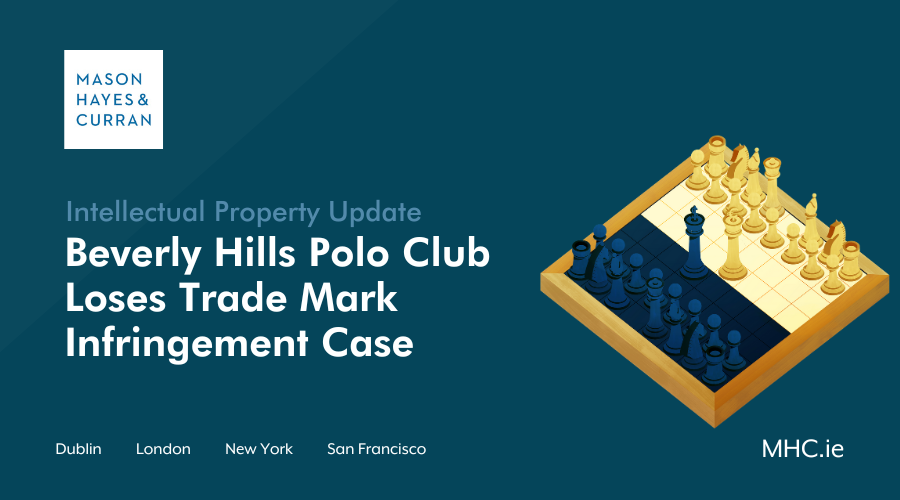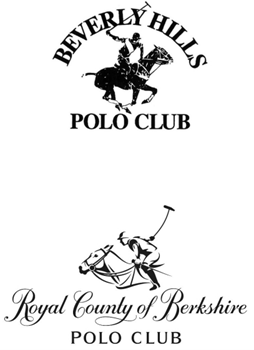Beverly Hills Polo Club Loses Trade Mark Infringement Case
Conflicting Polo Club Marks in a Crowded Market

In a battle of the competing Polo Clubs, the Beverly Hills Polo Club brand has lost a trade mark infringement and passing off case. The case, which it brought against Royal County of Berkshire Polo Club, was decided before the UK High Court. Our Intellectual Property team considers the decision in light of the difficulties facing brand owners to both protect and enforce their trade marks in the fashion industry.
The Beverly Hills Polo Club brand has lost a trade mark infringement and passing off case which it brought against Royal County of Berkshire Polo Club in the UK, the EU, and a number of other countries in South America. Passing off is a form of unfair competition under Irish law. In a 77-page judgment delivered by the UK High Court in July 2023, the Court held that there was no likelihood of confusion between the competing Polo Club marks depicted below. We consider the decision and its impact for brand owners in the fashion industry.

Background
In a number of trade mark oppositions and cancellation actions brought in various territories around the world in recent years, Beverly Hills Polo Club has successfully persuaded trade mark tribunals that there is a likelihood of confusion between the competing marks above. In most if not all of those cases, the relevant tribunal either did not receive market evidence or did not take account of it. Beverly Hills Polo Club therefore relied on these decisions as supporting a finding of likelihood of confusion between the two signs above in claiming infringement in legal proceedings before the UK Courts. According to Mr Justice Mellor of the UK High Court, the main question which he had to decide was whether there exists a likelihood of confusion between the two marks in various countries. However, he contended the case “does raise in a stark form the scope of protection which is or should be afforded to a registered trade mark which is used in a crowded market i.e. a market in which there are several trade marks using similar motifs and which incorporate the same or similar words.”
Crowded market
All parties in the case accepted that the market for polo-themed goods was a ‘crowded’ one. Both Beverly Hills Polo Club and Royal County of Berkshire Polo Club had co-existence agreements in place with Ralph Lauren, the owner of the well-known Polo Ralph Lauren brand. The parties also accepted that after the Polo Ralph Lauren brand, the US Polo Association was the number two brand in the market by market share and consumer awareness. Beverly Hills Polo Club argued that while its brand could peacefully co-exist with Ralph Lauren and the US Polo Association, there exists a likelihood of confusion between its sign and that of the Royal County of Berkshire Polo Club.
Importance of evidence
A recurring and ever-present theme in the judgment is the UK High Court’s criticism of the evidence of confusion presented at trial by Beverly Hills Polo Club. In referencing the evidence of the Managing Director of one of the claimant companies, the Judge commented that “It is fair to say that he is a very passionate advocate for the BHPC [Beverly Hills Polo Club] brand. The extent of his passion means I must treat his evidence with some caution…The cross-examination revealed a number of points on which Mr Haddad had no personal knowledge but he was nonetheless prepared to assume and convey as fact whatever he perceived was in the best interests of the brand.” Regarding another Beverly Hills Polo Club witness, the Judge concluded that “it became increasingly apparent to me that she was essentially programmed to say that anything associated with RCBPC [Royal County of Berkshire Polo Club] was confusing.” In addition, Mr Justice Mellor was critical of marginal annotations in a key witness statement, which the Judge described as “either inaccurate or positively misleading” as well as misleading evidence about sales figures. Actual sales, the Judge commented, were of a significantly lower financial value than Beverly Hills Polo Club would admit.
Findings
The Court rejected the claim of trade mark infringement and passing off. In particular:
- The case on indirect infringement was rejected because the circumstances in the case, with the crowded market along with the elements in the competing marks “militate against anyone viewing the sign as a sub-brand or as a brand refresh.”
- The case on direct infringement also failed because in all of the territories “no significant portion of the relevant public was or is likely to be confused so as to warrant the intervention of the Court.” This was especially true for the UK, where UK average consumers “have a greater ability and propensity to distinguish between these brands because they will more clearly recognise the place name contained in each of the Mark and the Sign.”
- In Europe, Beverly Hills Polo Club’s strongest claim was in Italy where it had a reputation for menswear predominantly, with some kids wear, footwear, bags and accessories also. However, trading had taken place against the backdrop of Ralph Lauren Polo, of which the average consumer in Italy would be aware. For that reason, there had been no infringement of Beverly Hills Polo Club’s EU trade marks in Italy or elsewhere in the EU.
- Ultimately, the Court held that the average consumer would make no link between the competing marks. At best, a consumer might wonder whether there was a connection and conclude there was not due to the differences between the Mark and the Sign. The claim in passing off therefore also failed.
Comment
Given that Beverly Hills Polo Club have historically been vigilant in protecting their trade marks to date, there is a strong likelihood that this judgment will be appealed and that we have not yet reached the end of the matter. The key takeaway for brand owners from the UK High Court judgment is the importance of presenting evidence in an ordered, accurate and un-biased manner.
In this case, the Court was very clearly swayed by both the weaknesses and gaps in the evidence presented as well as the general lack of it. In addition to criticising Beverly Hills Polo Club’s oral and written evidence, the Court also noted that “if there really was confusion occurring between these brands by purchasing consumers, I would have expected a much more substantial body of incidents to have been reported and recorded.” Brand owners should ideally seek to gather detailed and voluminous evidence of actual confusion, where it is available, before instituting legal proceedings seeking relief for trade mark infringement or passing off.
For more information and expert advice, please contact a member of our Intellectual Property team.
The content of this article is provided for information purposes only and does not constitute legal or other advice.
Share this:



